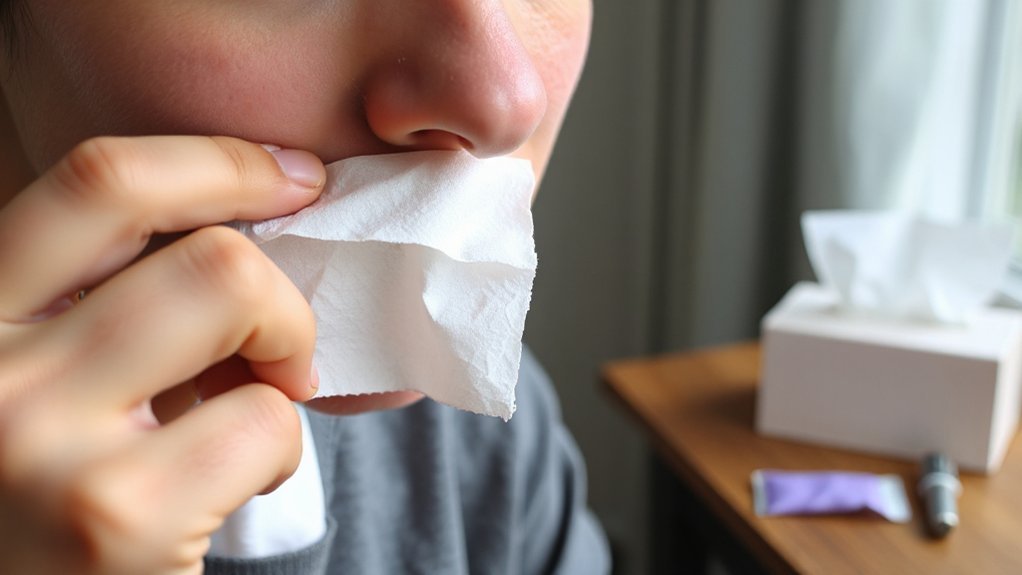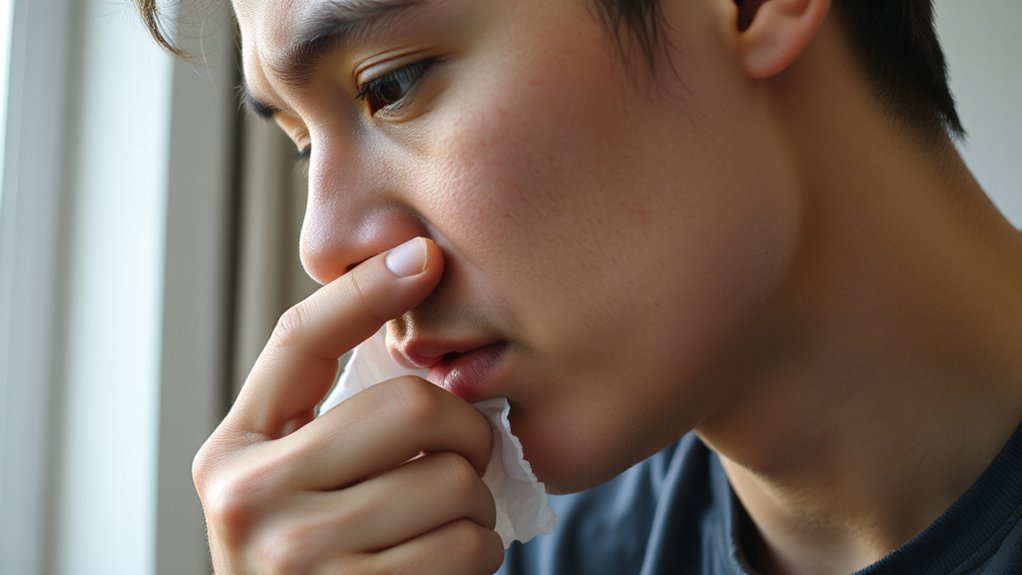If your nose starts bleeding, sit upright and lean slightly forward so blood doesn’t run down your throat, then firmly pinch the soft part of your nose for 10–15 minutes without checking. Breathe through your mouth and avoid tilting your head back or stuffing tissues into your nostrils. These simple steps stop most bleeds, but there are key signs and follow-up measures you should know about next.
Key Takeaways
- Sit upright, lean forward slightly, and breathe through your mouth to avoid swallowing blood.
- Pinch the soft lower part of your nose firmly for 10–15 minutes without checking.
- Use a cold compress on the bridge of the nose if bleeding continues after initial pressure.
- Avoid tilting your head back, stuffing the nostrils, or blowing your nose for several hours after bleeding stops.
- Seek medical care if bleeding lasts over 20–30 minutes, you feel faint, or you take blood thinners.
What Causes Nosebleeds

Nosebleeds happen when blood vessels inside your nostrils break and bleed, most often from the fragile capillaries in the front of the septum (Kiesselbach’s plexus). You’ll encounter common causes like dry air, which desiccates mucosa, and nasal allergies that inflame and weaken vessels. Frequent picking or forceful nose blowing mechanically disrupts capillaries. Medications effects — particularly anticoagulants and nasal steroids — increase bleeding risk by altering clotting or thinning mucosa. Systemic contributors include blood disorders and uncontrolled high blood pressure, both of which make bleeding more likely and harder to stop. Environmental factors such as cold, low-humidity climates and occupational irritants exacerbate mucosal fragility. Acute facial injuries can lacerate vessels directly and require assessment for deeper damage.
Immediate Steps to Stop the Bleeding

Start by sitting upright and leaning slightly forward so blood drains out of your nostrils, not down your throat; pinch the soft part of your nose firmly with your thumb and index finger for 10–15 minutes without releasing to check. Keep breathing through your mouth and avoid speaking or swallowing repeatedly. Use a tissue to catch runoff; don’t sniff or blow your nose immediately afterward. Apply a cold compress to the bridge of your nose to constrict vessels if bleeding continues after initial pressure. Stay calm and monitor bleeding rate; prolonged or heavy bleeding requires medical attention. Note environmental contributors: climate factors and dry environments can predispose you to recurrent bleeds, so plan humidification and nasal lubrication once bleeding stops to reduce recurrence.
First-Aid Positions and Techniques

Although it can feel alarming, position and technique make the difference between a quick stop and prolonged bleeding: sit upright, lean slightly forward, and firmly pinch the soft part of your nose for 10–15 minutes without checking; breathe through your mouth and keep your head steady to maintain consistent pressure and reduce swallowing of blood. You’ll use simple first-aid positions that target nasal anatomy and control blood flow.
- Pinch: Use thumb and index finger on the soft nasal cartilaginous area to compress the Kiesselbach plexus.
- Lean forward: Keeps blood out of the throat and lets you monitor volume and color.
- Hold time: Maintain continuous pressure for 10–15 minutes; avoid intermittent checks that interrupt clot formation.
If bleeding persists beyond 20–30 minutes, seek medical care.
Things to Avoid During a Nosebleed
Don’t tilt your head back — that can make blood run down your throat and increase choking or vomiting risk. Don’t stuff tissues or cotton deep into your nostril, which can disrupt clots and cause more bleeding. Don’t blow your nose hard after a bleed, since pressure can reopen the vessel you just controlled.
Tilting the Head Back
One common mistake is tilting your head back during a nosebleed; doing so can let blood run down your throat, increase swallowing, and raise the risk of vomiting or aspiration. You should avoid tilting methods that send blood posteriorly. Correct head positioning keeps blood out of the airway and helps you monitor bleeding.
- Stay slightly forward: lean at the waist, keeping the head above the heart to reduce bleeding and prevent ingestion.
- Keep the chin down: a small forward tilt controls flow without hyperflexing or hyperextending the neck.
- Support the head: use your hand or a pillow to maintain steady positioning while you apply pressure to the nose.
These steps are practical, clinical, and focused on airway safety; they replace unsafe tilting back habits.
Stuffing Tissues Inside
Stuffing tissues or cotton deep into your nostrils may seem like a quick fix, but it can worsen bleeding, push clots inward, and obstruct airflow. You shouldn’t pack tissue types indiscriminately; some shed fibers, others compress unevenly, increasing trauma to fragile mucosa. Avoid inserting small, loose pieces that can become lodged and require removal by a clinician. Instead, use external compression and lean forward while pinching the soft part of your nose. Maintain gentle nasal hygiene—clear only visible discharge with a soft tissue held at the nostril edge once bleeding stops. If you rely on absorbent materials for recurrent bleeds, consult a provider about safer options. Seek medical care for persistent bleeding, inhaled foreign material, or breathing difficulty.
Heavy Nose Blowing
Avoid forceful nose blowing while a bleed’s active; it can dislodge clots, restart bleeding, and drive blood backward into your throat or sinuses. You should minimize disturbance to the clot and avoid heavy nose blowing effects that worsen bleeding. Gentle care reduces nasal tissue damage and prevents recurrent bleeding.
- Stop: Don’t blow hard — you’ll remove clots and extend bleeding.
- Breathe quietly: Mouth-breathe until bleeding stops to avoid pressure changes.
- Wait: Hold pressure for 10–15 minutes, then inspect; if you must clear mucus, do it gently.
If bleeding recurs after gentle inspection, repeat pressure and avoid further force. Seek medical care for persistent hemorrhage, frequent episodes, anticoagulant use, or visible nasal tissue damage.
When to Seek Medical Care
If bleeding doesn’t stop after 20 minutes of firm pressure or it’s soaking through gauze or clothing, get medical help right away. Seek care sooner if you’re faint, short of breath, dizzy, vomiting blood, or have a head injury. Also call if you’re on blood thinners, have frequent nosebleeds, or notice heavy bleeding from one nostril.
When to Get Help
When should you seek medical care for a nosebleed? You should act when routine self-care doesn’t stop bleeding or when circumstances raise concern about complications. Know when to worry and pursue timely medical intervention.
- If bleeding lasts longer than 20–30 minutes despite firm pressure and leaning forward, get urgent care — you may need nasal packing or cautery.
- If you’re dizzy, fainting, short of breath, or vomiting blood, seek immediate emergency care — these signs suggest significant blood loss or airway risk.
- If you’re on blood thinners, have a bleeding disorder, recent facial trauma, or recurrent nosebleeds, contact your clinician for evaluation and treatment planning.
Signs of Serious Bleeding
Although most nosebleeds are mild and stop with simple first aid, certain signs mean you need prompt medical help. If bleeding lasts more than 20 minutes despite firm forward pressure, call emergency services. Seek care for repeated episodes, heavy blood loss, or bleeding after head trauma. Watch for signs and symptoms of shock: pale skin, rapid pulse, lightheadedness, fainting, or low blood pressure; these suggest severe conditions requiring immediate treatment. If you’re on blood thinners, have a bleeding disorder, uncontrolled high blood pressure, or active vomiting of blood, get urgent evaluation. Also seek medical attention for blood coming from both nostrils and the throat, difficulty breathing, or when home measures repeatedly fail. Document onset, duration, and any anticoagulant use.
Home Treatments and Remedies That Help
Home remedies can stop most anterior nosebleeds quickly and safely; you’ll need to sit upright, lean forward slightly, and pinch the soft part of your nose for 10–15 minutes without peeking. Use these practical measures and stay calm.
Sit upright, lean forward, pinch the soft part of your nose for 10–15 minutes—stay calm.
- Apply firm pressure: pinch nostrils and breathe through your mouth; use a cold compress on the bridge to constrict vessels.
- Use topical measures: apply a small amount of petroleum jelly inside the nostril or absorbent gauze; saline spray can moisten membranes—natural remedies like humidified air and saline help, and hydration tips (drink water) support mucosal recovery.
- Avoid provocations: don’t tilt your head back, don’t blow or pick your nose for several hours.
Seek care if bleeding persists beyond 20–30 minutes or is heavy.
Preventing Future Nosebleeds
Prevent future nosebleeds by addressing common triggers and strengthening your nasal lining: keep indoor air humidified, apply a thin layer of saline or petroleum jelly inside each nostril nightly, stay well hydrated, avoid vigorous nose blowing and picking, and review medications (like blood thinners or nasal sprays) with your clinician that might increase bleeding risk. Use a humidifier regularly in dry seasons or heated homes to reduce mucosal cracking. Choose nasal moisturizers—saline sprays, gels, or ointments—rather than frequent topical decongestants. Trim fingernails, discourage nose picking, and blow gently. Manage allergies and colds promptly to limit inflammation. If you have recurrent bleeds despite these measures, document frequency and triggers, then consult ENT for evaluation of septal issues, local cautery, or systemic causes.
Special Considerations for Children and Seniors
Because children and seniors have different anatomy, habits, and medical risks, you should use tailored approaches for managing and preventing nosebleeds in these groups. You’ll act differently depending on age, weighing child behavior and senior precautions when you care for someone.
Because children and seniors differ in anatomy and risks, use age-tailored approaches when managing and preventing nosebleeds.
- For children: stay calm, sit them up, pinch the soft part of the nose for 10 minutes, distract to reduce panic, avoid nose picking, and use humidifiers to limit mucosal dryness.
- For seniors: apply the same immediate measures but monitor medications (anticoagulants), check for hypertension, and favor saline sprays over topical vasoconstrictors.
- When to seek help: persistent bleeding beyond 20–30 minutes, recurrent episodes, or signs of significant blood loss require prompt medical evaluation.
Keep instructions simple, documented, and age-appropriate.
What to Expect at the Doctor’s Visit
When you see the doctor for a nosebleed, expect a focused exam of your nasal passages, essential signs, and medication review. The doctor’s examination will check bleeding source, clotting, blood pressure, and general stability. You’ll be asked about duration, frequency, trauma, nasal sprays, anticoagulants, and medical history. The clinician may suction and use topical vasoconstrictor or cautery to stop active bleeding. If bleeding recurs or is heavy, they’ll discuss anterior or posterior packing, nasal tampons, or arterial ligation — clear treatment options tied to severity. You may get tests: CBC, coagulation panel, or imaging for suspected structural causes. Expect instructions on follow-up, wound care, activity limits, and when to return or seek emergency care.
Conclusion
You’ve learned the common causes and practical steps to control a nosebleed. Sit upright, lean forward, and pinch the soft part of your nose for 10–15 minutes without checking; breathe through your mouth. Avoid tilting back, stuffing tissues, or blowing your nose hard. Seek medical care if bleeding won’t stop, is heavy, follows trauma, or if you’re on blood thinners. Use humidifiers and gentle nasal care to prevent recurrences and protect fragile nasal tissues.